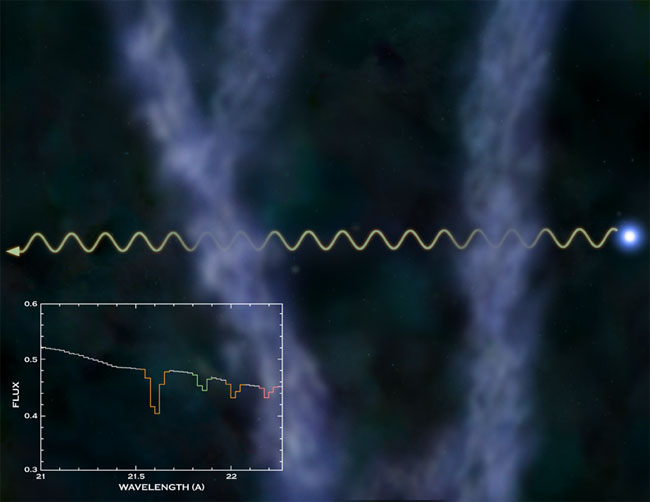Researchers: Some Missing Matter Found

Only about 5 percent of the mass and energy in the universe is normal matter, the subatomic particles that make up all things visible. Scientists have no clue what the other 95 percent is, so they've dubbed part of it dark matter and the rest dark energy.
Even a good portion of the normal matter, the 5 percent slice of the overall pie, has proved elusive to spot. New observations have found some of it.
The total mass of the universe, visible and hidden stuff, is calculated based on how stars huddle in galaxies and the fact that clusters of galaxies are gravitationally glued together. Normal matter alone can't explain the full gravity of this universal situation.
Dark energy is presumed to exist because the universe is expanding at an ever-increasing pace, and something must be driving that acceleration.
The 5 percent of normal matter includes stars, planets, their satellites, plus interstellar and intergalactic gas.
The new observations, by NASA's Chandra X-ray Observatory, reveal two huge intergalactic clouds of diffuse hot gas. These clouds are the best evidence yet that a vast cosmic web of hot gas contains the long-sought missing matter, scientists said Wednesday.
Normal matter is referred to as baryons.
Breaking space news, the latest updates on rocket launches, skywatching events and more!
"An inventory of all the baryons in stars and gas inside and outside of galaxies accounts for just over half the baryons that existed shortly after the Big Bang," explained Fabrizio Nicastro of the Harvard-Smithsonian Center for Astrophysics. "Now we have found the likely hiding place of the missing baryons."
The results are detailed in the Feb. 3 issue of the journal Nature.
Computer simulations of the formation of galaxies and galaxy clusters indicated that the missing baryons might be contained in an extremely diffuse web-like system of gas clouds from which galaxies and clusters of galaxies formed.
These clouds have defied detection because of their predicted temperature range of a few hundred thousand to a million degrees Celsius, and their extremely low density. Evidence for this warm-hot intergalactic matter (WHIM) had been detected around our Galaxy, or in the Local Group of galaxies, but the lack of definitive evidence for WHIM outside our immediate cosmic neighborhood made any estimates of the universal mass-density of baryons unreliable.
Nicastro and colleagues looked at X-rays coming from a distant bright galaxy called Markarian 421 as they passed through a region of warm gas. The X-rays were absorbed by ionized oxygen and nitrogen atoms there that are normally 'invisible,' and the scientists say that there is enough matter in the gas to account for the missing mass.
But these are just two gas clouds, so more observations are needed.
"It is difficult to know whether this region is typical of the entire universe," writes J. Michael Shull in a related commentary in the journal.
- Dark Energy Tied to Human Origins

Space.com is the premier source of space exploration, innovation and astronomy news, chronicling (and celebrating) humanity's ongoing expansion across the final frontier. Originally founded in 1999, Space.com is, and always has been, the passion of writers and editors who are space fans and also trained journalists. Our current news team consists of Editor-in-Chief Tariq Malik; Editor Hanneke Weitering, Senior Space Writer Mike Wall; Senior Writer Meghan Bartels; Senior Writer Chelsea Gohd, Senior Writer Tereza Pultarova and Staff Writer Alexander Cox, focusing on e-commerce. Senior Producer Steve Spaleta oversees our space videos, with Diana Whitcroft as our Social Media Editor.
